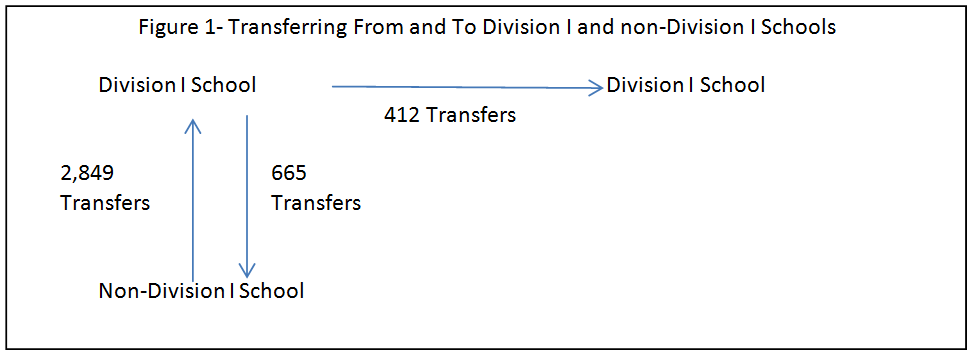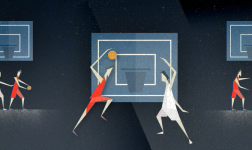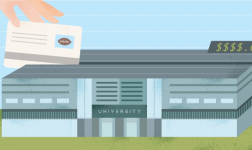The issue of student-athlete transfers has garnered attention in recent months as the NCAA is reportedly considering changes to the rules governing these transfers. Student-athlete transfers from one school to another school occur fairly often. The reasons for these moves vary widely, but as long as student-athletes receive permission to transfer from the institution that they would like to leave, they are free to compete at another school. Restrictions are placed on these decisions; however, NCAA rules mandate that a student-athlete forego competing for the team to which he or she transferred for one calendar year. The penalty of sitting out for a season is especially costly for top student-athletes who anticipate playing professionally but have relatively short careers.
Listen below to Winthrop Intelligence’s Stats Speak podcast for an in depth interview with Drs. McFall and Bronars.
In this article we examine transfers in men’s college basketball in order to understand the patterns of transfers and whether coaching change causes more student-athlete transfers. We analyzed a database with information about the 4,106 transfers at all divisions of men’s college basketball between 2002 and 2013. 1 We present our findings below, paying particular attention to the information on 3,596 transfers that involved a Division I team at either end of the transfer process, and to the 412 intra-Division I transfers.
Our database found 2,849 student-athletes leaving non-Division I schools for Division I schools, and 665 student-athletes leaving Division I schools for schools in lower divisions. We summarize the types of transfers we observe in Figure 1.
About 90% of transfers in our database involve student-athletes moving from or to a non-Division I school, which suggests the regulations regarding transfers within Division I affect strongly student-athletes’ decisions to leave a school. Of the 4,106 transfers in our database, only 412 student-athletes transferred from a Division I school to another Division I school. Given the possible reasons for a transfer, we pay close attention to moves within Division I, as almost all involve a student-athlete with the means to continue playing basketball at the highest collegiate level. A student-athlete who moved within Division I might decide that the transfer to another school where, presumably, his skills were valued more highly was worth the penalty imposed by the NCAA.
We summarize within Division I transfers in Table 1. Among these 412 transfers, 188 transfers left schools that are in one of the, what are commonly referred to as, BCS conferences, and of these student-athletes, 139 moved to programs in non-BCS conferences. We find these types of transfers interesting because athletic departments in BCS conferences tend to have the highest expenditures within Division I. This means that the student-athletes who transferred away from these schools and conferences had been receiving the most expensive coaching and training amongst the student-athletes we observe. Because these student-athletes are leaving for programs with lower budgets, we assume their motive for the transfer is to use their enhanced skills in a higher-profile role with their new team. These student-athletes likely could have committed to the school to which they are transferring while in high school. But changes in their individual situation and/or the roster of their Division I team means that they now value more playing time and a higher profile enough to offset the penalty they face for deciding to transfer.
The remaining 49 student-athletes transferred from schools within BCS conferences to another school in a BCS conference. Of course, most of these student-athletes had to serve the transfer penalty, but because they remained at schools with the highest profiles within Division I basketball; we assume they transferred not just for a higher profile role, but perhaps for a better fit with a team that has a style of play better matching their skills than their original school.
Finally, our database contains information on 41 student-athletes who transferred from a BCS school to a non-BCS school. The relatively low number of transfers of this type suggests that either the recruiting process is efficient at identifying student-athletes who have the high-level skills required to play at a Division I school, but won’t be able to participate meaningfully at a BCS school, or that the transfer regulations limit these moves to maintain competitive balance.
With regard to the latter proposition, teams that are most likely to achieve substantial runs in the NCAA tournament largely come from the BCS conferences, and these are the teams that would benefit the most from being able to appropriate the skills of a student-athlete for only one season (or less). The penalty for transferring makes it much harder to meet this proposition, thus maintaining a measure of competitive balance across Division I teams. The NCAA likely wants to avoid the practice seen in some professional sports of larger market teams “renting” a star player for a year, often from a smaller-market team, in order to make a title run. In professional sports, the smaller-market team can obtain prospects, younger players, and a reduction in player costs because these moves are made as a trade where both teams can benefit. In men’s college basketball we don’t view these transfers as being mutually beneficial for the smaller profile team.
In a similar vein, we also observe transfers from and to Division I schools based upon expense differences of the schools involved in the transfer. The expense estimates are for the 2010-11 season, and were published by the Memphis Business Journal in 2012. 2 We separated schools into quartiles by expenses. We reached similar conclusions using this yardstick compared to the BCS versus non-BCS comparison.
In total, 419 student-athletes transfers involve teams with expense data. Only 66 student-athletes transferred from a school in a lower expense quartile to a school in a higher expense quartile, a number that is consistent with our findings that differentiated between BCS and non-BCS teams. Again, we conclude that the relative scarcity of these types of transfers support the notion that NCAA transfer regulations work to maintain competitive balance. On the other hand, there were 222 student-athletes who transferred from a school in a higher quartile of expenses to a school in a lower expense quartile.
Finally, we observe 131 student-athlete transfers between schools with similar spending on their programs. These observations are consistent with student-athletes taking their training to a school that offers an opportunity at a higher profile role.
The following tables describe how coaching changes for a men’s basketball program is related to the transfer rate of student-athletes in and out of the program. 3 It is also true that even relatively stable programs can experience an increase in transfers at the time of a coaching change. Of the 1,077 transfers we observe from a Division I program, 203 (approximately 19%) of the transfers occurred at the same time as a coaching change. The other 874 transfers occurred in years in which there were no coaching changes. Given that there are about 340 Division I teams in each year (of the ten year window that the database tracks), this figure amounts to about 0.3 transfers per team, per year in which there were no coaching changes, and about 0.45 transfers per team, per year in years in which there was a coaching change. These numbers suggest that part of the cost of finding a new coach is increasing the incentive for student-athletes to transfer.
We expect transfer rates to or from a school to be affected by the stability of the men’s basketball program, as measured by the number of head coaching changes a school has had since 1998. Schools with high turnover of head coaches might have trouble keeping or attracting student-athletes. We don’t find large differences between schools that are relatively stable (which we define as having only one or two head coaches since 1998), and schools with higher turnover at the head coaching position. As Tables 2 and 3 shows, schools with higher turnover amongst head coaches tend to lose student-athletes to transfers at a higher rate than more stable teams, while less stable schools rely on transfers slightly more than more stable teams. However, the differences are slight on average, and suggest that, for whatever reason student-athletes do transfer, relative stability across programs doesn’t seem to be huge factor in their decision making process.
The restriction on transferring to another NCAA team is similar to a covenant-not-to-compete (CNC), a contractual tool used in many industries that limits worker movement to competing firms. In labor markets, CNCs are used to keep workers from appropriating, on the open market, the value of the training that they received from their current employer—the firm that likely paid for at least some of the training. Workers who receive training that is portable across firms are often asked to agree to CNCs. Computer programmers, lawyers, and real estate agents are often cited as industries in which CNCs are common.
In many ways, NCAA teams behave like firms using the CNC to limit their exposure to the risk of employee turnover, after training has been provided to employees. Teams develop skilled student-athletes by providing expensive coaching and training to recruits, and these experienced players are valued by other schools. But the similarities between firms’ use of CNCs and the NCAA’s transfer regulations end there, as the NCAA must also regulate the competitive balance between its member schools. Its rules place important checks on student-athletes’ transfers to schools that might be benefit for an upcoming season.
NCAA members understand the need to maintain a level playing field, and this goal can be aided by rules regulating transfers. But even with penalties for transferring, some student-athletes find it in their best interest to attend another school. The simplest way to generalize the reason why a student-athlete transfers is that they believe the expected benefits from finding a better position with another team is more than enough to offset the costs of transfer. Given that it is rare to observe a student-athlete moving to a Division I school with a higher profile than the school from which he transferred, we surmise that these athletes, the athletes who are most likely to play professionally after they leave college, view the penalty for transferring to another Division I team as being too large relative to the benefits they might accrue from the transfer.
In this important sense, the NCAA player-transfer rules help maintain competitive balance in men’s college basketball. Without the penalty, athletes could move to other teams mid-season, thus throwing off much of the sense of balance or continuity within the sport.
 Dr. McFall is a visiting assistant professor who teaches in the Economics Department at Wake Forest University. He earned a PhD in 2005 from North Carolina State University, where he received a department-level award for his dissertation and a university-level award for his teaching. Dr. McFall’s research includes the economics of sports.
Dr. McFall is a visiting assistant professor who teaches in the Economics Department at Wake Forest University. He earned a PhD in 2005 from North Carolina State University, where he received a department-level award for his dissertation and a university-level award for his teaching. Dr. McFall’s research includes the economics of sports.
 Dr. Bronars is a senior economist in the Washington, DC, office of Welch Consulting . Dr. Bronars received his PhD in economics from the University of Chicago. Before joining Welch Consulting, he was the Leroy Denman Jr. Regents Professor and Chairman of the Economics Department at the University of Texas at Austin. He has held faculty positions at the University of California, Santa Barbara, Texas A&M University, Yale University, and the WhartonSchool, and is currently an adjunct professor at Georgetown University.
Dr. Bronars is a senior economist in the Washington, DC, office of Welch Consulting . Dr. Bronars received his PhD in economics from the University of Chicago. Before joining Welch Consulting, he was the Leroy Denman Jr. Regents Professor and Chairman of the Economics Department at the University of Texas at Austin. He has held faculty positions at the University of California, Santa Barbara, Texas A&M University, Yale University, and the WhartonSchool, and is currently an adjunct professor at Georgetown University.
Key Insights
The NCAA’s policies regulating student-athletes’ decisions to transfer are similar to covenants-not-to-compete (CNC) that firms in private labor markets use to mitigate the possibility that skilled employees leave for a competitor. With this view in mind, we analyzed a database that tracks men’s college basketball transfers since 2002 and found evidence that the policies do protect competitive balance. We attempt to find evidence of the impact that coaching turnover has on the number of transfers from and to teams. We find some evidence suggesting that coaching turnover affects player turnover. Few transfers move from a lower-profile Division I team to a higher-profile Division I team, the type of team most likely to make a substantial postseason tournament run. These are the types of transfers higher-profile teams would seek in an attempt to shore up weaknesses with players with certain skills.
References:
- Our database contains observations of transfers that occurred at all levels of collegiate basketball between 2002 and 2012.
- http://www.bizjournals.com/memphis/news/2012/03/13/many-top-ncaa-tournament-teams-spent.html ↩
- Coaching change data from ESPN.com, CBSsports.com, and Win ADdatabases.
http://www.cbssports.com/collegebasketball/story/17543646/college-basketball-coaching-changes ↩








